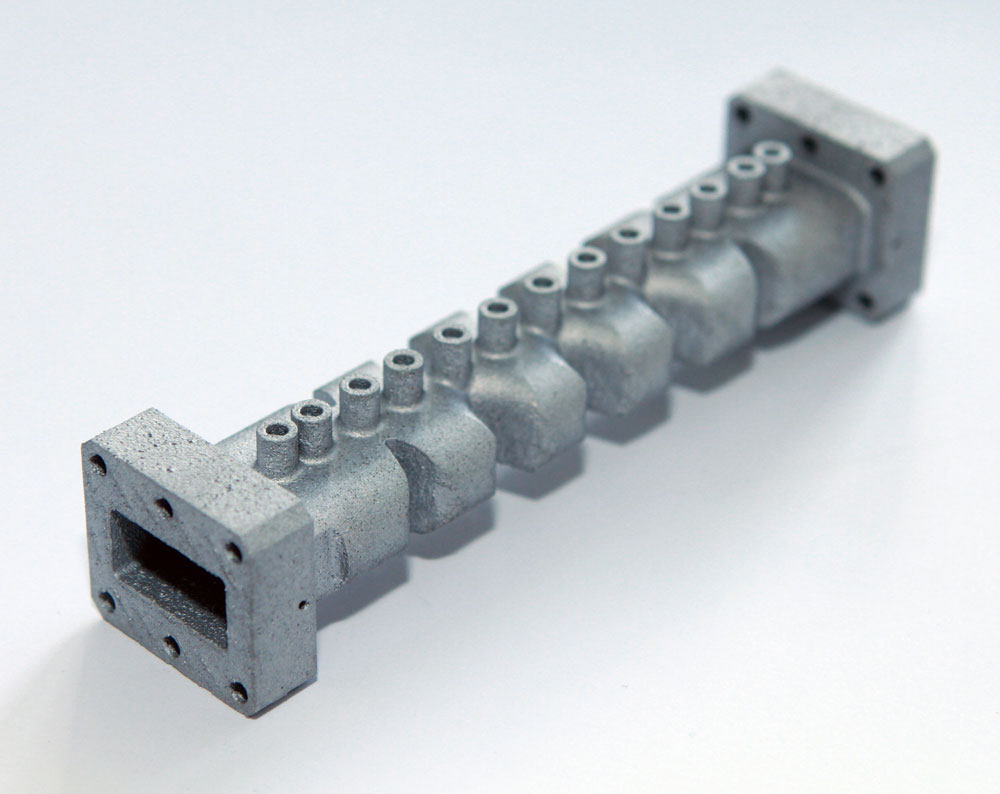 TESAT-Spacecom, one of Germany’s largest space technology companies, has pioneered the application of additive manufacturing techniques, also known as 3D printing, for the production of microwave components. The breakthrough took place within the framework of an activity supported by ESA through the ARTES Advanced Technology programme.
TESAT-Spacecom, one of Germany’s largest space technology companies, has pioneered the application of additive manufacturing techniques, also known as 3D printing, for the production of microwave components. The breakthrough took place within the framework of an activity supported by ESA through the ARTES Advanced Technology programme.
Additive manufacturing has been used for many years in medical technology for producing, amongst other things, metallic implants and bone and tooth replacements. More recently, this technique has evolved to the stage where high-quality aluminium parts can be produced. In an approach known as Additive Layer Manufacturing (ALM), metallic powder is deposited layer by layer, and a high-power laser with a beam size in the order of 1/10 mm is used to weld pre-defined shapes for each layer.
Up until recently, the application of this manufacturing technique for microwave components was hindered by the properties of the manufactured part (surface roughness, tolerances, voids, plating) that resulted in degraded performance. In the ARTES-supported activity, a team from TESAT and Fraunhofer ILT, with the assistance of ESA technical experts, was able to overcome this issue, paving the way to using this technique to produce, for the first time, single-piece microwave components made from aluminium, including filters, couplers, and waveguide runs.
Using this technique, very complex single-piece components can be produced in a short time, at reasonable cost and in small numbers. Almost arbitrary geometries can be produced that are not possible or are very difficult and expensive to obtain with traditional milling techniques.
ESA support for the application of ALM in the European space industry dates back to 2008 when ESA internal studies confirmed the potential of this technology for use in space. The success of the internal studies has led to a series of ALM development activities in the framework of the ARTES programme in which TESAT took part.
"The results of these efforts are quite impressive,” says ESA Microwave Engineer César Miquel España, who oversaw the activity. “We are now seeing RF performance equivalent to traditionally manufactured parts, often with reduced mass as well."
“Since 2015 ALM has become a part of our daily work,” says TESAT’s Dr. Siegbert Martin, Head of Passive Microwave Products. “We have started using RF devices made by ALM in our test area. This generates cost savings on the one hand, on the other we learn and understand the technology more and more.”
“At first we started replacing milling production, but now we are changing our ways of thinking and finding solutions by using the full potential of ALM”, Dr. Martin continues. “We are very keen to use this new manufacturing technology, and our new developments already take ALM design guidelines into consideration. The space industry is requesting innovations and we have now the means at hand to deliver. After further performance evaluations this year, we are targeting to supply flight models in 2017.”
“The space industry is geared towards small series production of complex parts. This is precisely the strength of additive manufacturing,” says ESA's Christoph Ernst. “Achieving performance acceptable for RF space hardware in the frame of the ARTES program is a breakthrough. It enables not only a new cycle of optimisation in terms of mass and performance but also quicker turn-around of early prototypes and reduction of delivery times can be expected.”




